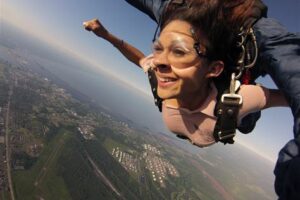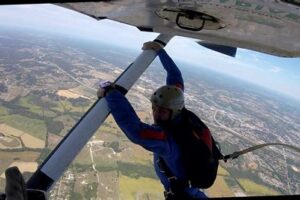Table of Contents
Looking for the perfect skydiving helmet? Find top-quality skydiving helmets designed for safety and comfort. Explore a wide range of options with advanced features such as impact resistance, ventilation systems, and secure fit. Stay protected during your exhilarating skydiving adventures with the best helmets in the market.
Skydiving helmets are an essential piece of equipment that should never be underestimated. Whether you are a novice or an experienced skydiver, the importance of protecting your head cannot be overstated. Not only do these helmets provide a vital shield against potential injuries, but they also enhance your overall skydiving experience. With their advanced features and cutting-edge technology, skydiving helmets offer unparalleled safety and comfort. Moreover, they are specifically designed to withstand the extreme conditions of freefall, making them an indispensable companion for any skydiving adventure. So, let’s delve into the world of skydiving helmets and explore why investing in a high-quality one is an absolute must for anyone seeking an exhilarating and secure skydiving experience.
Safety First: The Importance of Skydiving Helmets
Skydiving is an exhilarating and adrenaline-pumping activity that attracts thrill-seekers from all walks of life. As with any extreme sport, safety should always be a top priority. When it comes to skydiving, one essential piece of equipment that should never be overlooked is the skydiving helmet. This article aims to shed light on the significance of wearing a helmet during skydiving and why it should be an integral part of every skydiver’s gear.
The Role of a Skydiving Helmet
A skydiving helmet serves as the ultimate protective gear for your head during freefall and canopy descent. It is designed to shield your head from potential impacts with other skydivers, aircraft, or debris. In the event of an unexpected collision or accident, a well-fitting helmet can significantly reduce the risk of head injuries and concussions, providing much-needed peace of mind for both beginners and experienced skydivers alike.
The Construction of Skydiving Helmets
Skydiving helmets are specially constructed with the highest safety standards in mind. They typically consist of a hard outer shell made from materials such as carbon fiber or fiberglass, which provides excellent impact resistance. Inside the helmet, you will find a layer of foam padding that not only ensures a snug fit but also offers additional protection against shocks and vibrations.
Types of Skydiving Helmets
There are various types of skydiving helmets available, each catering to different preferences and requirements. The most common types include:
- Full-Face Helmets: These helmets provide complete coverage for the head, including the face. They offer superior protection and are particularly favored by those participating in high-speed disciplines such as formation skydiving or wingsuit flying.
- Open-Face Helmets: As the name suggests, these helmets leave the face exposed while still offering protection to the rest of the head. Open-face helmets are typically more comfortable and allow for better communication during jumps.
- Camera Helmets: Designed specifically for skydivers who wish to capture their jumps on camera, these helmets come equipped with built-in mounts or brackets to attach action cameras securely.
The Importance of Proper Helmet Fit
When it comes to skydiving helmets, one size does not fit all. Achieving a proper helmet fit is crucial for optimal safety and comfort. Ill-fitting helmets can be both uncomfortable and ineffective in protecting your head. To ensure the best fit, helmets often come with adjustable straps and padding that can be customized according to your head shape and size. Before making a purchase, it is advisable to try on different helmets to find the one that fits you perfectly.
Additional Considerations
While helmets are essential for skydiving safety, they should not be relied upon as a standalone solution. It is equally important to follow all safety protocols, undergo proper training, and maintain awareness of your surroundings during every jump. Remember, a helmet is just one part of the equation; responsible and educated skydiving practices are paramount.
Choosing the Right Helmet
When selecting a skydiving helmet, it is crucial to choose one that meets industry safety standards. Look for helmets that are certified by recognized organizations such as the International Skydiving Commission (ISC) or the United States Parachute Association (USPA). Additionally, consider your specific needs and preferences, such as the type of skydiving you plan to engage in and any additional features you may require.
Inspecting and Maintaining Your Helmet
Regular inspection and maintenance of your skydiving helmet are essential to ensure its continued effectiveness. Inspect the outer shell for any visible cracks or damage, and check the padding and straps for wear and tear. Follow the manufacturer’s guidelines for cleaning and storage. If your helmet has been involved in a significant impact, it is advisable to replace it, even if no visible damage is detected.
In Conclusion
Skydiving helmets are not just a fashion statement; they are a critical component of skydiving safety. Investing in a high-quality helmet that fits properly and meets safety standards is an investment in your well-being. Remember, there is no compromise when it comes to your safety, so always make sure to wear your helmet whenever you take to the skies for an unforgettable skydiving adventure.
The Importance of Skydiving Helmets
Skydiving helmets play a critical role in ensuring the safety and well-being of skydivers. With the potential risks involved in the sport, such as impact, windblast, and debris, having proper head protection is essential. These helmets are designed to provide reliable protection against these hazards, giving skydivers the assurance they need to enjoy their jumps with peace of mind.
Protection and Safety Assurance
The primary function of skydiving helmets is to protect the head from potential dangers during a jump. They are specifically engineered to absorb impact forces, reducing the risk of head injuries in the event of a collision or hard landing. By wearing a helmet, skydivers can mitigate the potential consequences of accidents and ensure their safety throughout the entire jump.
Impact Resistance
Skydiving helmets are constructed with durable materials and advanced technology to withstand high-impact forces. They are designed to absorb and distribute the energy generated during a collision, minimizing the impact on the wearer’s head. By providing enhanced shock absorption, these helmets significantly reduce the risk of severe head injuries, making them a vital piece of equipment for skydivers.
Secure Fit and Comfort
A properly fitting skydiving helmet is crucial for both comfort and safety. These helmets come with adjustable straps and interior padding, allowing for a personalized fit that conforms to an individual’s head shape and size. This ensures a secure and snug fit, preventing any movement or discomfort during the jump. By prioritizing comfort, skydivers can fully focus on their experience without any distractions.
Types of Skydiving Helmets
Full-Face Helmets
Full-face skydiving helmets offer maximum head protection by providing coverage for the entire face. These helmets are favored by skydivers, especially those involved in high-speed activities or when jumping in colder temperatures. The full-face design not only protects against impact but also helps shield the face from windblast and extreme weather conditions.
Open-Face Helmets
Open-face helmets provide adequate head protection while allowing for greater peripheral vision and easy communication with other skydivers. They are popular among experienced skydivers and those engaging in formation or group jumps. The open-face design allows for better situational awareness, making it easier to coordinate movements and maintain visual contact with fellow skydivers.
Camera Helmets
Designed specifically for skydiving photographers and videographers, camera helmets feature built-in mounts to securely attach cameras or other filming devices. These helmets ensure optimal stability, allowing professionals to capture stunning footage without compromising their safety. By providing excellent Point of View (POV) shots, camera helmets are essential for documenting and sharing the exhilarating experience of skydiving.
Key Considerations When Choosing a Skydiving Helmet
Safety Certification
When selecting a skydiving helmet, it is crucial to ensure that it meets the necessary safety standards. Look for certifications from reputable organizations such as the United States Parachute Association (USPA) or the European Committee for Standardization (CE). These certifications indicate that the helmet has undergone rigorous testing and meets the required safety criteria, giving you peace of mind during your jumps.
Materials
The materials used in skydiving helmets play a significant role in their reliability, durability, and overall protection. Helmets are typically constructed with fiberglass, carbon fiber, or other sturdy synthetic materials. Opting for a helmet made from high-quality materials ensures that it can withstand the demands of skydiving and provide superior protection against impact.
Ventilation
Proper ventilation is crucial in a skydiving helmet to ensure comfort during long jumps. Look for helmets with adequate ventilation systems, adjustable vents, or removable inserts that allow for airflow and temperature regulation. Optimal ventilation helps prevent overheating, reduces fogging, and ensures a pleasant experience throughout the jump.
Signs Indicating the Need for Helmet Replacement
Damage or Wear
Regularly inspect your skydiving helmet for any signs of damage. Cracks, dents, or loose parts can compromise the helmet’s ability to protect your head effectively. Additionally, helmets with worn-out padding or straps should be replaced to maintain optimal safety standards. It is essential to prioritize the integrity of your helmet and replace it promptly if any damage or wear is detected.
Age and Usage
Over time, the structural integrity of a skydiving helmet can degrade due to exposure to UV rays, impacts, or general wear and tear. It is recommended to replace a helmet every 5-7 years or following a significant impact. By adhering to these guidelines, you can ensure that your helmet remains in optimal condition and continues to provide the necessary protection during your skydiving adventures.
Changes in Personal Needs
If you transition from one skydiving discipline to another, such as moving from recreational jumps to more advanced maneuvers, you may require a different type of helmet. Different disciplines may have specific safety requirements or preferences, and having a helmet that aligns with your new skill set and needs is crucial. Always assess your personal needs and choose a helmet that best suits your evolving skydiving journey.
In conclusion, skydiving helmets are of utmost importance when it comes to the safety and well-being of skydivers. They provide crucial head protection against potential risks and are designed to withstand high-impact forces. With different types of helmets available, skydivers can choose one that suits their specific needs and preferences. When selecting a helmet, it is essential to consider safety certifications, materials used, and ventilation options. Additionally, regular inspections and timely replacement of helmets are necessary to maintain optimal safety standards. By prioritizing the importance of skydiving helmets, skydivers can enjoy their jumps with confidence, knowing that they have taken the necessary precautions to protect themselves in this exhilarating sport.
In the world of skydiving, safety is paramount. Every precaution must be taken to ensure the well-being of the skydiver throughout their exhilarating journey. One such precaution that cannot be overlooked is the use of a skydiving helmet. These helmets are an essential piece of equipment that provide numerous benefits and enhance the overall safety of the skydiving experience.
Here are several key points highlighting the importance and advantages of using skydiving helmets:
-
Protection: The primary function of a skydiving helmet is to protect the head and brain from potential injuries. During a skydive, there is always a risk of accidental collisions with other skydivers, aircraft, or even the ground. A sturdy helmet can significantly reduce the impact of such collisions and minimize the risk of severe head trauma.
-
Aerodynamics: Skydiving helmets are designed to be streamlined, reducing air resistance and allowing for a smoother descent. This aerodynamic advantage not only enhances the overall performance of the skydiver but also improves stability and control during freefall.
-
Communication: Most modern skydiving helmets come equipped with built-in communication systems. These systems allow skydivers to communicate with each other and their instructors during the jump. Clear communication is crucial for safety and coordination, especially when jumping in groups or performing complex formations.
-
Visibility: Helmets often feature visors or goggles that protect the eyes from wind, debris, and UV rays. These visors also improve visibility by reducing glare and providing a clear field of vision. Having unobstructed sight is vital for assessing the surroundings, maintaining awareness, and making necessary adjustments during the skydive.
-
Equipment Integration: Skydiving helmets are designed with various attachment points, allowing for the integration of other essential equipment. Items such as altimeters, audible altimeters, and cameras can be securely mounted onto the helmet, ensuring easy access and minimal interference during the jump.
In conclusion, skydiving helmets are not just optional accessories; they are a critical component of skydiving safety equipment. These helmets provide necessary protection, enhance performance, facilitate communication, improve visibility, and offer equipment integration capabilities. Skydivers must prioritize their safety and always wear a well-fitted and certified helmet to mitigate potential risks and fully enjoy the thrill of the sport.
Thank you for taking the time to visit our blog and learn more about skydiving helmets. We hope that the information we have provided has been useful in helping you understand the importance of this essential piece of equipment for every skydiver. As professionals in the field, we believe that safety should always be the top priority when it comes to any extreme sport, and skydiving is no exception.
First and foremost, it is crucial to understand that a skydiving helmet is not just a fashion statement or a way to look cool while soaring through the sky. It serves a critical purpose in protecting your head from potential injuries. Whether it’s a sudden impact during freefall or an unfortunate collision with another skydiver or object during landing, a high-quality helmet can make all the difference in preventing serious head trauma.
When choosing a skydiving helmet, there are several factors to consider. Firstly, it is essential to find a helmet that fits properly and snugly on your head. This ensures maximum protection and prevents the helmet from coming off in case of an accident. Additionally, look for helmets that are certified by reputable organizations such as the US Parachute Association (USPA) or the European Skydiving Standards and Training Organization (ESSTO). These certifications guarantee that the helmet meets rigorous safety standards and has been tested for durability and impact resistance.
In conclusion, investing in a high-quality skydiving helmet is a decision that should not be taken lightly. Your safety and well-being are priceless, and a helmet can significantly reduce the risk of head injuries while engaging in this thrilling sport. Remember to choose a helmet that fits correctly and is certified by reputable organizations, as these are key indicators of its safety and reliability.
Thank you once again for visiting our blog, and we hope that you now have a better understanding of the importance of skydiving helmets. Stay safe and enjoy your future skydiving adventures!
.
1. Do I really need a skydiving helmet?
Yes, wearing a skydiving helmet is highly recommended for your safety during a skydiving adventure. It provides protection for your head and can minimize the risk of injuries in case of any unforeseen events or accidents.
2. What features should I look for in a skydiving helmet?
When choosing a skydiving helmet, consider the following features:
- Impact resistance: Look for a helmet that meets safety standards and has been tested for impact resistance.
- Comfort: Ensure the helmet fits well and is comfortable to wear for extended periods.
- Secure fit: Look for helmets with reliable chin straps or retention systems to keep it securely in place.
- Visibility: Opt for a helmet with good peripheral vision and easy-to-use visor systems for maximum visibility during freefall.
- Communication options: Some helmets come with built-in communication systems, allowing you to communicate with instructors or fellow skydivers while in the air.
3. Can I use my own helmet for skydiving?
If you already own a helmet that meets the safety standards and requirements for skydiving, you may be able to use it. However, it’s always recommended to consult with a professional skydiving instructor or equipment specialist to ensure your helmet is suitable and meets the necessary safety standards.
4. Are full-face helmets better than open-face helmets?
Both full-face and open-face helmets have their advantages and considerations. Full-face helmets provide better overall protection, covering your entire face, including the chin and jaw. They are particularly beneficial in colder weather conditions as they offer more insulation. On the other hand, open-face helmets provide better visibility and ventilation. Ultimately, the choice between the two depends on personal preference and the specific needs of the skydiver.
5. How often should I replace my skydiving helmet?
It’s recommended to replace your skydiving helmet every 5 years or sooner if it has been subjected to significant impact or damage. Regularly inspect your helmet for any signs of wear, cracks, or deterioration, and consult with a professional if you have any concerns about its integrity.






